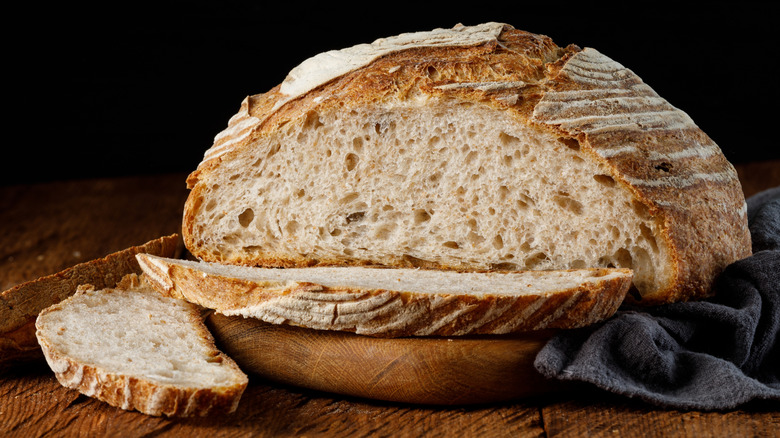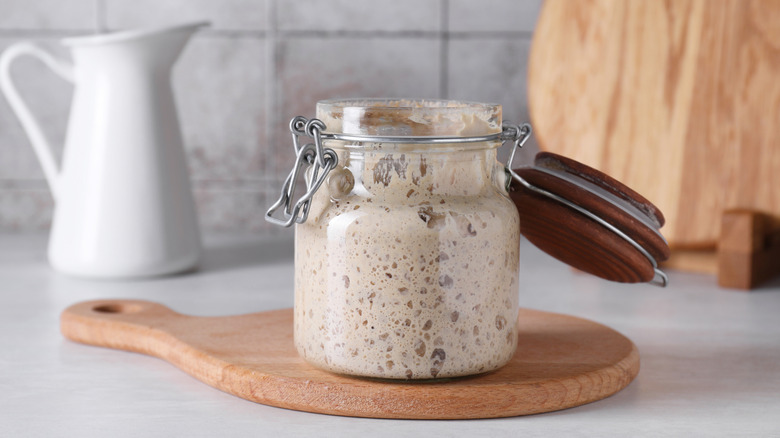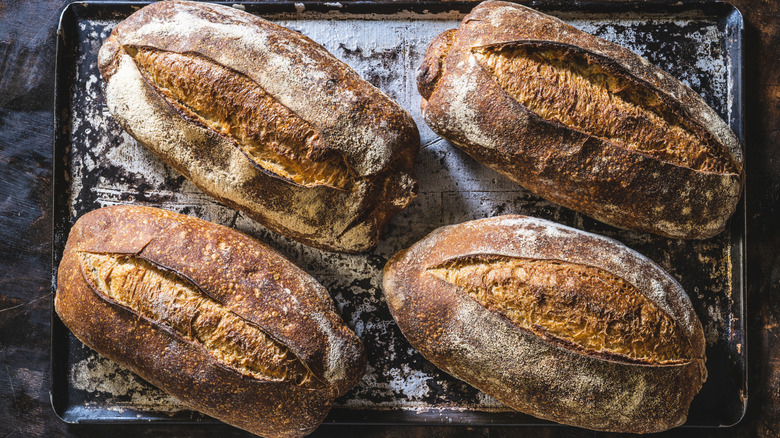The Biggest Mistake Beginners Make With Sourdough Bread
The reason sourdough tastes different compared with other breads is all to do with the fermented starter used to make it. It's also one of the things that can be especially daunting for beginner bakers. To find out what can go wrong, and learn how to prevent the most common mistakes, we sought some expert advice from Nathan Myhrvold, founder of Modernist Cuisine and co-author of "Modernist Bread at Home."
To make a sourdough starter from scratch, you need to mix equal amounts of flour and water and allow the mixture to ferment with the wild yeast it picks up during the process. But since it's a living culture, it needs regular feeding with more flour and water to thrive. The biggest error beginners make with their starters is being inconsistent, according to Myhrvold. "From a microbiology standpoint, if you don't maintain consistency on all levels, a starter's exact composition is likely to be different from week to week, or even from day to day," he explained.
To keep your sourdough starter healthy, you need to focus on three key elements — "availability of nutrients, acidity, and temperature," said Myhrvold. This means feeding your starter at the same time every day. "In our tests, this was the single biggest factor that affected its quality and the quality of the bread made with it," he said.
A consistent temperature is key for a healthy sourdough starter
As well as regular feeding, it's important to keep the temperature consistent if you want a good sourdough starter. "Our tests showed that different temperatures had a measurable effect on the starter's pH levels, which correlate to acidity," explained Nathan Myhrvold. "The higher the ambient temperature, the faster the rate of fermentation, which can result in a slightly more acidic starter." This essentially means that you need to feed your starter more if the temperature is higher — twice a day if it's on the kitchen counter, versus more like once a week in the fridge.
While you might be tempted to feed your starter more frequently in a warmer environment (or in the summer) and less when it's cooler, Myhrvold advised against this approach. Instead, focus on maintaining a consistent temperature where possible. "A starter can actually starve if it's too hot," explained Myhrvold. Plus, "if you feed it too frequently, you can dilute the starter so much that it will lose its leavening power and acidity."
The starter will be at its best when kept in the region of 75 to 82 degrees Fahrenheit. If your house is usually less than 68 degrees Fahrenheit, you may want to find somewhere a little warmer to develop the starter. Then you just need to wait patiently for the sourdough starter to become ripe so you can start baking.
How soon can you bake your first sourdough loaf?
It's clear that sourdough takes time and patience, but once you've nurtured your healthy starter, how quickly can you start baking actual loaves of bread with it? The "initial inoculation period, which is when the culture initially takes root and gets up and running," takes about four days according to Nathan Myhrvold. "The portion of starter that you remove after that point can be used for baking," while "the souring process levels off after around 10 days."
In practice, even though it could be ready within seven days, you'll probably want to wait a couple of weeks from creating your starter until you start baking for the best results. Look out for it becoming bubbly, and doubling in size around six hours after you've fed it. You can also see if it floats when you put a teaspoon of the starter into a bowl of cold water — if so, it's ready.
On the other hand, it's also important to watch for signs you need to throw out your sourdough starter. These include any indications of mold as well as if you notice pink or orange colors developing. This, too, is part of the sourdough learning curve, even though it may seem upsetting for beginners. The key is "don't get too attached to your starter — it isn't magic," advised Myhrvold. "It's just flour and water. You can always start a new one."


